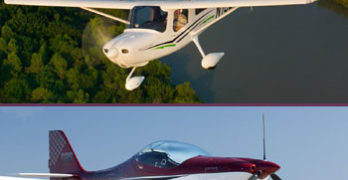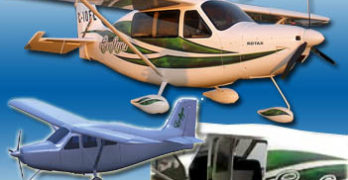Despite a widespread financial funk, the Sebring U.S. Sport Aviation Expo — commonly referred to as the Sebring LSA Expo — is fast approaching. This #5 Sebring starts the year and has become a place where new aircraft debuts are staged. Yes, a few exhibitors have pulled out to conserve cash. But most aircraft you want to see will be present. *** Paradise will have their new hand control P-1. A CTLS with the new Garmin 696 installed will be on display. An upgraded Remos GX will show…and the list goes on. *** One new LSA entry you’ll see will be the all-American Lightning LS-1 (photo) from Arion Aircraft. Though powered by Australia’s Jabiru engine the entire airframe is Made-in-the-USA. I flew a kit-built version and was highly impressed by its performance and handling. Lightning’s speed range was one of the widest I’ve ever experienced.
Search Results for : search.cfm
Not finding exactly what you expected? Try our advanced search option.
Select a manufacturer to go straight to all our content about that manufacturer.
Select an aircraft model to go straight to all our content about that model.
Year Ends with New SLSA: Welcome FA-04 Peregrine
On December 29th, a new Special Light-Sport Aircraft was approved. With only a couple days remaining in this challenging year, I suspect this will be the final approval of 2008. Welcome to the FA-04 Peregrine, which was inspected after assembly at Hansen Air Group in the Atlanta area. I believe this to be the first LSA from former East Germany (which was ironically named German Democratic Republic even though it was Communist). *** FA-04 Peregrine is a low-wing carbon fiber LSA that evolved from Flaeming Air‘s FA-02, which earlier had won European VLA approval. The interior is 44 inches wide (a Cessna 172 is 39.5 in.) with “lots of legroom” and a large luggage compartment that makes the model appropriate for longer cross country flights. Adjustable seats aid occupant comfort. In an interesting variation, Peregrine has main landing gear that can “easily be converted to a taildragger,” said Jon Hansen.
Like Economy, the Euro Is Down but You Gain!
This week we’ve heard of a couple price rollbacks based on the euro/dollar exchange rate favoring the dollar. Notably among them is the EuroFox by Aeropro sold in this country by Rollison Light Sport Aircraft . Buyers can save a whopping $10,000 on what was already one of the better-priced SLSA. Now at $58,950, the folding wing, snappy-flying EuroFox — available in taildragger or tri-gear configurations — looks to be a surprising value. Importer Rob Rollison says financing is available to make a EuroFox even more affordable. *** Lots more appears on the horizon for RLSA, which has been involved with light sport aviation since before the beginning. Rob has been hinting about new airplanes he may represent. Plus, EuroFox will go through a name change in 2009. New name or not, EuroFox surprises many who look it over closely, myself included. I expected a factory-produced “kit plane” yet the finished SLSA is quite professionally achieved.
Remember the Cumulus Motorglider? It’s Flying!
In the 1990s I tried my hand at developing an airplane. While that business venture didn’t make me a millionaire, it provided a valuable lesson about what it takes to stay in the light-sport airplane business. Later, I realized the project needed someone who understood building techniques better than I did. That man was Dave Ekstrom and he ultimately took over my design, the Cumulus, a motorglider. He calls his business Ultralight Soaring Aviation LLC .
In the world of soaring, a motorglider is an expensive flying machine, making it not so different than high-end LSA that cost $130,000 or more. But Ekstrom comes from the world of homebuilts and he knew he could produce a kit for a lot less if buyers were willing to pull a few rivets (about 300 total hours are needed).
One of the 21 Cumulus builders is Andre Girard of Ottawa, Canada, who kindly provided Dave with the photos you see (five Cumulus kits are now airborne).
Light-Sport Aircraft Mature–Legend’s Celebration
Legend has good reason for celebration (and no, this has nothing to do with Obama’s election). In the lifespan of Light-Sport Aircraft — the first deliveries reach their fourth anniversary next April — Legend was an early success…a story that continues to unfold. The Sulfur Springs, Texas producer has come a long way while handily maintaining their status as, by far, the largest American-based producer of LSA. *** Recently, Legend celebrated the third anniversary of its first Legend Cub customer delivery. In August 2005, the builder handed over the keys to the company’s first newly manufactured Legend Cub to Rich Giannotti of Long Island, New York, launching the startup company. In the three years following, American Legend and their sibling kit company, Texas Sport Aircraft, report deliveries of more than 160 aircraft (not all SLSA). *** Along the way Legend has consistently added new features or options to the classic design.
Free Straight & Level Button for Sting S3 Owners
Recently I visited Cirrus Design. I saw progress on the Cirrus Vision jet and the new Garmin Perspective panel for the SR22. Both aircraft are full of high-end avionics. *** Down here in the world of Light-Sport Aircraft, we have far less costly choices for flat-screen avionic displays (panels in the Vision or SR22 literally cost more than an entire LSA). Yet the data each set of instruments uses is identical. LSA are also often equipped with autopilots…again, far less expensively compared to the certified units GA builders install. *** Recently SportairUSA announced their new “Straight & Level” button. If you find yourself in the soup unexpectedly, the pilot or passenger can push one button causing the autopilot to take over by guiding the airplane while the occupants assess their next move. It’s a brilliant idea to give pilots a breather. “The Straight and Level system is a significant advance in flight safety for Sting owners,” says Bill Canino, operator of SportairUSA, “That’s why we are providing it at no additional cost on all of ourTruTrak EFIS/autopilot equipped Stings.” The SL button even turns the autopilot on if it was off…a mighty smart airplane at a fraction of the cost of similarly equipped GA airplanes.
Flying through Turbulence; Even Big Boys Affected
Most producers in the Light-Sport Aircraft sector welcomed the LSA market entry announced by Cessna and Cirrus at Oshkosh 2007. July of last year looks like the “good old days,” as aviation from LSA to VLJs — essentially all of GA — is roiled by global economic uncertainty. *** Compounding the challenges, Cessna had an “unrecoverable” spin incident with their Skycatcher 162. Even BRS got drawn in with a rocket-deployed parachute that for reasons yet unknown didn’t save the airframe. Both companies are sure to work out these issues; test failures are an accepted part of aircraft development. *** Cirrus stepped down to a 3-day workweek (AvWeb article) to cope with slowing sales. Like Cessna, Cirrus is managing multiple developments. Their jet project consumes plenty of resources so when watching costs, it’s little surprise that the Duluth company might put their SRS Light-Sport project on the back burner.
3Xtrim Navigator Is Newest SLSA (#86)
At Sebring 2007, I flew an enjoyable airplane from Poland with the uninspiring name of 3X55 Trainer (see my blog post). A re-engineered and renamed Navigator 600 received SLSA certification on August 22, 2008. [UPDATE 2/19/09] — The North American importer is 3Xtrim Inc. *** Navigator grew up and now boasts a 1,320 pound gross weight and a useful load of 600 pounds with a 47.2-inch cabin width, specified producer, 3Xtrim. I thought 3X55 looked small but she felt sufficiently roomy inside. 3X55 was also very straightforward to fly at modest speeds (88 knots at cruise). And it was so simple to land that the earlier model easily justified the “Trainer” label. *** [UPDATE 7/1/09] 3Xtrim, Inc., reports several N-numbered Navigator 600s are flying in the U.S. and four more are expected soon. Base price for a reasonably well-equipped Navigator is $99,000.
Chubby LSA from Canada Offers Huge Interior
Just one glance at the Canadian-developed Ecoflyer confirms its size. Looking like an overweight American, Ecoflyer nonetheless boasts enough room to set up a small dining table in a spacious cabin that could later be converted to your bedroom. Ecoflyer’s cabin contains 152 cubic feet of volume, only 13 feet less than a Chrysler minivan that seats seven. You may only be able to take one family member along but if you want to fly your LSA to a remote field and camp for the night, Ecoflyer could be your Light-Sport flying machine. “It’s intended to be used as shelter when on the ground,” said Bernard Laferrière, president of Explorer Aéronautique, based in French-speaking Québec. The flying seat backs flip around so two occupants can face aft. Two more can sit facing forward in an aft cavity. *** Empty weight is a fairly remarkable 750 pounds, low considering even the simple Cub-like LSA designs have to work hard to stay below the LSA maximum empty weight of 890 pounds.
Bilsam Sky Cruiser Wins SLSA (#84)
They still sneak by…under the radar. Welcome to Sky Cruiser, which won approval before Oshkosh. As the LSA industry heads toward its #100 SLSA approval — perhaps by the April 2009 fourth-year anniversary date since the first approval — welcome to #84 (previously reported #85). *** Built by Bilsam Aviation in Poland, the Sky Cruiser is represented in the U.S. by Joe Carswell’s Light Wing Sport Aircraft. His company also sells Allegro and X-Air plus Titan kit-built aircraft, all of which occupy the lower price range of Light-Sport Aircraft. Based in Morganton NC, Light Wing provides flight training at Clyde Valley Airport. *** To top out their line of modestly priced LSA, the Carolina company imports the Sky Cruiser. Plenty of technology details or specs can be found on the Bilsam website but the highlights are: Cruise 108 knots with a 100-hp Rotax 912 swinging a 3-blade carbon prop; stall 40 knots; climb 1,050 fpm; gross weight 1,298 pounds; empty weight 704-770 pounds, depending on equipment selected, which can include an optional factory installed parachute; 26-gallon fuel capacity yielding a 600 mile range; and a broad 48-inch wide cabin.
- « Previous Page
- 1
- …
- 7
- 8
- 9
- 10
- 11
- 12
- Next Page »











